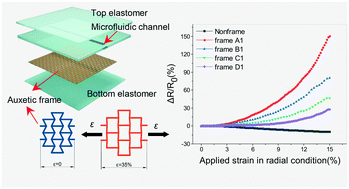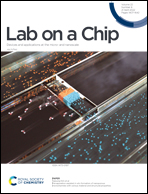Configurable direction sensitivity of skin-mounted microfluidic strain sensor with auxetic metamaterial†
Abstract
Electromechanical coupling plays a key role in determining the performance of stretchable strain sensor. Current regulation of the electromechanical coupling in stretchable strain sensor is largely restricted by the intrinsic mechanical properties of the device. In this study, a microfluidic strain sensor based on the core–shell package design with the auxetic metamaterial (AM) is presented. By overriding the mechanical properties of the device, the AM in the package effectively tunes the deformation of the microfluidic channel with the applied strain and configures the directional strain sensitivity with a large modulation range. The gauge factor (GF) of the strain sensor in the radial direction of the channel can be gradually shifted from the intrinsically negative value to a positive one by adopting the AMs with different designs. By simply replacing the AM in the package, the microfluidic strain sensor with the core–shell package can be configurated as an omnidirectional or directional stretchable strain sensor. With the directional sensitivity brought by the rational AM design, the application of the AM-integrated strain sensor in the skin-mounted tactile detection is demonstrated with high tolerance to unintended wrist movements.

- This article is part of the themed collection: Miniaturised Sensors & Diagnostics


 Please wait while we load your content...
Please wait while we load your content...